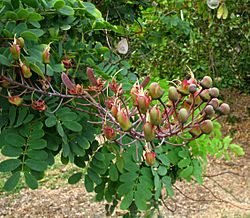Mezoneuron kauaiense facts for kids
Quick facts for kids Mezoneuron kauaiense |
|
|---|---|
 |
|
| Conservation status | |
| Scientific classification | |
| Kingdom: | |
| (unranked): | |
| (unranked): | |
| (unranked): | |
| Order: | |
| Family: | |
| Genus: |
Mezoneuron
|
| Species: |
M. kavaiensis
|
| Binomial name | |
| Mezoneuron kavaiense (H.Mann) Hillebr.
|
|
| Synonyms | |
|
|
Mezoneuron kavaiense, often called Uhiuhi or Kāwaʻu, is a very rare flowering plant that grows only in Hawaii. It is part of the pea family, called Fabaceae. This special plant is in danger because of invasive species (plants and animals that don't naturally belong there) and wild animals like feral ungulates (hoofed animals) that eat it.
Contents
What Does Uhiuhi Look Like?
The Uhiuhi plant can be a shrub or a small tree. It usually grows to be about 4 to 10 meters (13 to 33 feet) tall. Its bark is dark gray and looks like it's made of small, flat pieces.
The leaves are made up of 4 to 8 smaller leaflets. Each leaflet is about 3 centimeters (1.2 inches) long. The flowers have both male and female parts. They have pink to rose-colored sepals and red anthers. These flowers grow in clusters that are 4 to 7 inches (10 to 18 cm) long.
After blooming, the plant produces flat, thin seed pods. These pods are about 8 centimeters (3.1 inches) long and 5 centimeters (2 inches) wide. Each pod holds 2 to 4 oval-shaped seeds. Uhiuhi plants usually bloom from December to March.
Where Does Uhiuhi Live?
The Uhiuhi plant lives in different types of forests in Hawaii. These include dry forests, coastal mesic forests, and mixed mesic forests. It can be found at elevations from 80 to 920 meters (260 to 3,020 feet) above sea level.
Other plants that often grow near Uhiuhi include lama (Diospyros sandwicensis), ʻaʻaliʻi (Dodonaea viscosa), and alaheʻe (Psydrax odorata).
In the past, Uhiuhi plants grew on several Hawaiian islands. These included Kauaʻi (in Waimea Canyon), West Maui, Lānaʻi, the Big Island (in North Kona District), and Oʻahu (in the Waiʻanae Range). Today, you can only find them growing wild on the Big Island and Oʻahu.
How People Used Uhiuhi
The wood from the Uhiuhi tree is very special. It is extremely dense, hard, and almost black in color. It also has a very fine grain.
Native Hawaiians used this strong wood for many important tools and items. They made ʻōʻō (digging sticks) for farming and ihe (spears) for hunting or defense. They also crafted laʻau melomelo (fishing lures) and pou (posts for building houses).
The wood was also used for the runners of papa hōlua (sleds) used for a traditional sport. Other items included pāhoa (daggers), laʻau palau (clubs), and laʻau kahi wauke (boards for scraping Broussonetia papyrifera bark to make cloth).
The beautiful rose-colored flowers of the Uhiuhi plant were collected to make lei, which are traditional Hawaiian garlands. The plant was also used in traditional Hawaiian medicine. Young leaves, leaf buds, and bark were mashed with other plant parts to create a mixture believed to help purify the blood.
Why Uhiuhi Needs Our Help
The Uhiuhi plant is extremely rare today. There are fewer than 100 individual plants left in the wild. Some experts believe there might be even fewer than 50. The plant also has trouble reproducing successfully, meaning not many new plants grow from seeds.
The places where Uhiuhi lives have been damaged or destroyed. This is due to new buildings, farming, and fires. Also, many non-native plants and animals have invaded its habitat.
One very harmful invasive plant is fountaingrass. It covers large areas and makes the danger of fire much worse. Rats eat the Uhiuhi seeds, and animals like cattle and goats graze in the areas where the plants grow.
An insect called the black coffee twig borer also causes damage. It harms the young Uhiuhi seedlings and saplings. Because the wood is so valuable, the trees are still at risk of being cut down illegally.
The Uhiuhi plants on the Big Island grow on the side of Hualālai, which is a dormant volcano. This means they are technically in danger of being wiped out if the volcano were to erupt.
Because of all these threats, the Uhiuhi plant was officially listed as an endangered species by the United States government in 1986. This means it is protected by law.



